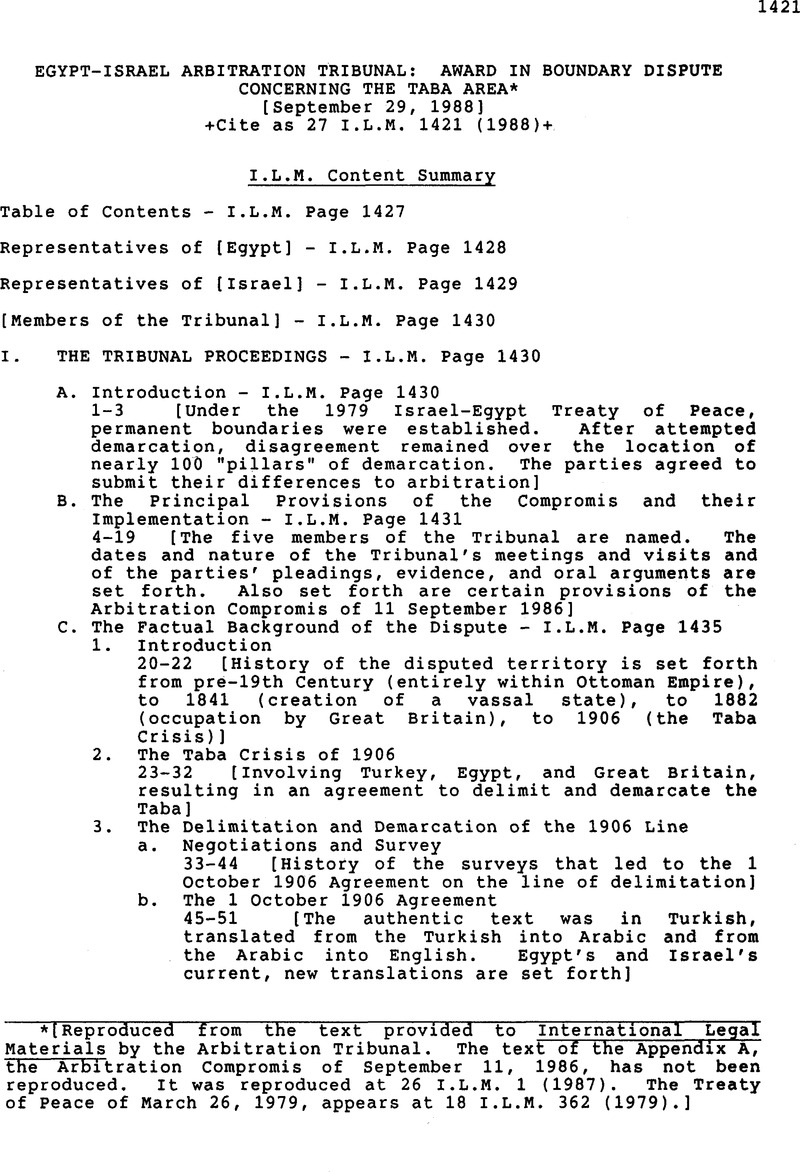Published online by Cambridge University Press: 27 February 2017

* [Reproduced from the text provided to International Legal Materials by the Arbitration Tribunal. The text of the Appendix A, the Arbitration Compromis of September 11, 1986, has not been reproduced. It was reproduced at 26 I.L.M. 1 (1987). The Treaty of Peace of March 26, 1979, appears at 18 I.L.M. 362 (1979).]
1 The background to this arbitration and the contentions of the Parties have been presented in the first part of the majority opinion, and will not be reiterated here.
2 See, e.g., the many examples quoted in A.L.W. Munkman, “Adjudication and Adjustment - International Judicial Decisions and the Settlement of Territorial and Boundary Disputes”, British Year Book of International Law. 46th year, 1972-1973, pp. 1-116.
3 American Journal of International Law. Vol. 5, 1911, pp. 782-833.
4 Moore, International Arbitrations. Vol. I, p. 119.
5 E.B.H. Wade, with additions by B.F.E. Keeling and J.I. Craig, A Report on the Delimitation of the Turco-Eavptian Boundary Between the Vilavet of the Heiaz and the Peninsula of Sinai (June—September 1906). Ministry of Finance, Egypt, Survey Department, Cairo, National Printing Department, 1907 (hereinafter “Wade Report”); Captain R.C.R. Owen, General Report on the Proceedings of the Sinai Boundary Commission. October 28th, 1906, Archives of the British Government (hereinafter “Owen's General Report”).
6 ICJ Reports 1986, p. 554, at p. 556.
7 Naum Bey Shoucair, Ancient and Modern History of Sinai and its Geography, with a Summary of the History of Egypt.Syria and Lebanon. Iraq and the Arabian Peninsula. Cairo (1916), p. 615.
8 S.B. Jones, Boundary-Making: A Handbook for Statesmen. Treaty Editors and Boundary Commissions. Carnegie Endowment for International Peace, Washington, D.C., 1945, pp 197-200. See also A.O. Cukwurah, The Settlement of Boundary Disputes in International Law. Manchester University Press, 1967, p. 79.
9 Ch. Rousseau, Droit International Public. Vol. 3, Paris, Sirey, 1977, pp. 270-71.
10 The word “probably” is intended to express some doubt since, according to N.B. Shoucair, Captain Parker left for Nakhl immediately after agreement on the shape of the boundary pillars was reached - see Naum Bey Shoucair, op. cit.. note 7, p. 615.
11 F.Münum;nch,“Kartenim Vönum;lkerrecht”, Gedänum;chtnisschrift fünum;r Friedrich Klein. Munich, 1977, pp. 335-354 at p. 344.
12 G. Ress, “The Delimitation and Demarcation of Frontiers in International Treaties and Maps”, in National and International Boundaries.Thesaurus Acroasium. Vol. XIV, Institute of International Public Law and International Relations of Thessaloniki, 1985, pp. 395-458, at p. 437.
13 See notes 8 and 9, supra.
14 Published in the Journal of the Central Asian Society. Vol. XV, 1928, p. 3, and reproduced in H.V.F. Winstone, The Diaries of Parker Pasha. Quartet Books, London, 1983, at p. 201.
15 ICJ Reports 1962, p. 34.
16 See supra note 6.
17 The Nufenenpass case, Entscheidunoen des Schweizerischen Bundesoerichts aus dem Jahre 1980, Amtliche Sammlung, 106 Band, Ib. Teil, p. 154. For a summary in English, see International Law Reports. Vol. 75, 1987, pp. 114-121.
18 Dr.Youssef Tony, Dictionary of Geographical Terms. 2d ed., Cairo (in Arabic).
19 S.B.Jones, op cit., note 8, at p. 148.
20 See D.Rushworth in Verbatim Record (V.R.), p. 557. Since I intend to rely with regard to several important matters on the testimony of Mr. D. Rushworth, the expert witness on behalf of Israel,itis appropriate to mention at this point some of his professional credentials. He is a graduate in civil engineering from London University and has a post- graduate diploma in geodesy from Oxford University.He is a Chartered Land Surveyor. He has much experience in surveying, cartography, and demarcation, acquired partly in the British army and partly in civilian functions. His experience relates both to the United Kingdom and overseas countries, including several Arab countries.
21 S.B.Jones,op cit., note 8, p. 215.
22 N.B.Shoucair,op cit., note 7, p. 614.
23 F. Münum;nch, op cit, note 11, at p. 335.
24 N.B.Shoucair, OP cit.. note 7, p. 62.
25 The majority brings two additional quotations from the reports: Owen used the expression “following along the top of the ridge north of Wadi Taba” (at p. 3), but this description is included in his analysis of the negotiations, not of the Agreement itself. However that may be, Israel's location for BP 91 is in conformity with this text since Owen speaks of the ridge north of Wadi Taba. The second quotation according to which “[t]he boundary-line, as finally agreed upon, runs for the most part along the watershed” (Owen, General Report, p. 10) is a general observation concerning the whole boundary and does not deal specifically with the Taba area: “no part of the boundary runs along a watershed in [this] area … there are lots of watersheds … here. Each of these ridges forms a watershed, but I don't see the line running along any of them … I would have thought it almost impossible to plot a line anything like the proposed lines that would stick to watersheds” (testimony by Mr. D. Rushworth, V.R., p. 653).
26 ”… it is a very uneven wall, at times only a few feet.high and running back in little gullies and other times rising almost cliff-like. That is south of Wadi Khadra. It is a very broken wall.” (Rushworth, V.R., p. 649; see also V.R., p. 560).
27 A Dictionary of Geological Terms. American Geological Institute, New York, 1962, as quoted in Egypt's Counter-Memorial.
28 Rushworth, V.R., pp. 565, 609.
29 Naum Bey Shoucair, op cit., note 7, at p. 62.
30 Reports of International Arbitral Awards. Vol. 17, at p. 530.
31 Ibid., pp. 551-552.
32 Sir Gerald Fizmaurice, “The Problem of non-liquet: Prolegomena to a Restatement”, in Melanges offerts a Charles Rousseau. Paris, Pedone, pp. 89-112, at p. 95.
33 See D.V. Sandifer, Evidence Before International Tribunals. Revised edition, 1975, p. 236. See also Mr. Rushworth's testimony on map-making, V.R., p. 567 et seg.
34 G. Sess, 2E cit.. note 12, at p. 421.